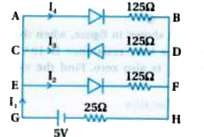In one atom of As is added per 103 atoms of Ge then the number of free electron in one mole of Ge will be …….. Solution in Gujrati
1017
1020
1010
1013
The correct Answer is:C
1010
1 As atom per 1013 Ge atom then,
at 1023 atoms of Ge?
N=1×10231013=1010
Topper's Solved these Questions
- SEMICONDUCTOR ELECTRONICS : MATERIALS, DEVICES AND SIMPLE CIRCUITS BOOK - KUMAR PRAKASHANCHAPTER - SEMICONDUCTOR ELECTRONICS : MATERIALS, DEVICES AND SIMPLE CIRCUITS EXERCISE - Section-D : Multiple Choice Questions (MCQs) (MCQs asked in Competitive Exams)
129 Videos
- SEMICONDUCTOR ELECTRONICS : MATERIALS, DEVICES AND SIMPLE CIRCUITS BOOK - KUMAR PRAKASHANCHAPTER - SEMICONDUCTOR ELECTRONICS : MATERIALS, DEVICES AND SIMPLE CIRCUITS EXERCISE - Section-C: NCERT Exemplar Solution (Long Answer Type Questions)
10 Videos
- SAMPLE QUESTION PAPER BOOK - KUMAR PRAKASHANCHAPTER - SAMPLE QUESTION PAPER EXERCISE - PART-B SECTION-C
5 Videos
- WAVE OPTICSBOOK - KUMAR PRAKASHANCHAPTER - WAVE OPTICSEXERCISE - SECTION-D (MULTIPLCE CHOICE QUESTIONS (MCQS)) (MCQS FROM DARPAN BASED ON TEXTBOOK)
239 Videos
Similar Questions
At absolute zero temperature Si acts as ……..
View Solution
If each diode in figure has a forward bias resistance of 25Ω and infinite resistance in reverse bias, what will be the values of the current I1,I2,I3andI4?
View SolutionTwo charges –q and +q are located at points (0, 0, –a) and (0, 0, a), respectively.
(a) What is the electrostatic potential at the points (0, 0, z) and (x, y, 0) ?
(b) Obtain the dependence of potential on the distance r of a point from the origin when r/a>>1 .
(c) How much work is done in moving a small test charge from the point (5,0,0) to (–7,0,0) along the x-axis? Does the answer change if the path of the test charge between the same points is not along the x-axis?
View SolutionAccording to particle theory of light what is the velocity of light in a dense medium, compared to that in rare medium ?
View SolutionAssuming that there is one free electron per atom in copper, determine the number of free electrons in 1 "metre"^(3) volume of copper. Density of copper is 8.9xx10^(3) kgm^(-3) and atomic weight 63.5. (Avogadro's number, N=6.02xx10^(26) per kg-atom).
View SolutionFind free electrons per unit volume in a wire of density 104kg/m3, atomic mass number 100 and number of free electron per atom is one.
View SolutionThere are two Ge crystals A and B. Few aluminium atoms are added to A while few lndium atoms are added to B. Then
View Solutionएक शुद्ध सिलिकॉन क्रिस्टल में प्रति मीटर3 परमाणुओं की संख्या 5×1028 है। इसमें पाँच संयोजकता वाले आर्सेनिक की प्रत्येक 106 परमाणु में एक परमाणु की अशुद्धि मिलायी जाती है। यदि ni=1.5×1016 प्रति मीटर3 हो तो अर्द्धचालक का प्रकार तथा उसमे इलेक्ट्रॉन व होल की संख्या ज्ञात कीजिए।
View SolutionThe density of copper is 9×103kgm−3 and its atomic mass is 63.5 u. Each copper atom provides one free electron. Estimate the number of free electrons per cubic metre in copper.
View SolutionA Ge specimen is doped with Al. The concentration of acceptor atoms is ~10^(21) atoms/ m^3 . Given that the intrinsic concentration of electron hole Paris is ~10^(19)//m^3 , the concentration of electrons in the specimen is :
View SolutionFind the number of acceptro atoms m^(3) in the silicon specimen on adding one indium atom per 5xx10^(8) the number density of atoms in silicon specimen is 5xx10^(28) atoms / m^(3)
View Solutionएक (Ge) जर्मेनियम क्रिस्टल नमूने में AI अशुद्धि के रूप में मिलाया गया है। ग्राही (Acceptor) परमाणुओं का घनत्व ~1021 atoms/ m3 है। यदि शुद्ध अवस्था में इलेक्ट्रॉन-होल युग्म का घनत्व ~1019/m3 हो तो नमूने में इलेक्ट्रॉनों का घनत्व होगा
View Solutionएक (Ge) जर्मेनियम क्रिस्टल नमूने में AI अशुद्धी के रूप में मिलाया गया है। ग्राही परमाणुओं का घनत्व ~1021 परमाणु मी−3 है । यदि शुद्ध अवस्था में इलेक्ट्रॉन-होल युग्म का घनत्व ~1019मी−3 हो, तो नमूने में इलेक्ट्रॉनों का घनत्व होगा
View SolutionIf one Al atom added to 109 per atom of Si then charge on holes in one mole will be ……….
View SolutionA Ge specimen is doped with Al. The concentration of acceptor atoms is 10^(21)"atoms/m"^(3) . Given that the intrinsic concentration of electron hole pairs is 10^(19)//m^(3) , the concentration of electrons in the specimen is …….
View Solution
